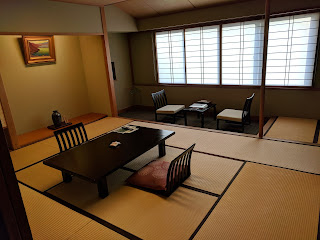two lakes and a mountain
That obscure little town we landed on was located in the largest but least populated county of Japan, with a 6500-foot-tall snow capped volcano mountain nicknamed "Mt. Fuji of northeast Japan", that could hardly escape our sight while we toured around it and two neighboring counties over the next few days.
A big deep crater lake to its south glittered and glimmered with a golden lady statue under the cold and haughty skies; another, far to the north on a lower terrain, was calm and classy against canopy blue, approachable and multi-faceted as we strolled around it.
Out of that calm and classy lake flew a quiet little creek, crossing a maple woodland, chaperoned by a miles long hiking trail and a few splattering water falls on its sides; then there was this other peaceful river that we floated on, in a straw-lined gondola, gliding past its ragged rock walls and drooping tree vines, listening to the operatic Japanese folk song singing by the gondola handler...
Led us through the rural farm lands for its season changing landscapes that happened to be brown and languid at this time of the year; some serendipitous catch of random scenes of beauty along the bus routes more than made up for the lackluster views from the trains, however.
You may have heard a weatherman forecasting a severe winter storm that might bring a "3 feet snow fall" with it, but did you ever see a wall of 15 foot tall snow piled up along the side of the road, on both sides, stretching for miles? That's what we did when our bus drove through the mountain range around Mt. Fuji of the northeast in one sunny afternoon!
A millennium year old temple housed a gold plated altar for Buddha and four generations of the regional warlords of old time Japan; one of the 12 remaining grand castles of Japan was setting up to be the fairground for the coming yearly cherry blossom festival; a grand samurai mansion is now an open museum that hosts not only samurai swords and costumes, but phonographs and anatomic paintings that evidence the westernization of Japan in the late 19th century.
hotels and onsens
All the three hotels we stayed in featured traditional Japanese style rooms, with tatami mats and low tea tables, and indoor and outdoor hot spring ("onsen", as the Japanese call it) bath chambers. The hot springs came from natural sources but smelled no sulfuric odor and looked crystal clear clean. I took the "hot soup" dip every early morning for the first two days, then in the evening also for the last two days once I got addicted to it!
Exquisite Japanese food, be it pre-arranged on a set plate or self-picked from the hotel buffet trolley, gave great satisfactory taste without stuffy feel, and was healthier than western diets, in my opinion, notwithstanding the fact I gained a few pounds after the trip.
We went with a group of 34 and knew a few of them at the end of this 5-day-short tour, like this one guy who might well be a tour guide himself explaining to us which six counties constitute the Japan northeast; another, owner of a flower arranging business, on how to tell different cherry trees apart by looking at the shapes and forms of their flowering buds...
And there were these two ladies, cousins between themselves, one a beauty salon owner the other a project manager at a major business software company, took every opportunity to shop--at the mall, the drug store, the super market, etc., and even had some items they ordered online before the tour ship to the hotel for themselves to pick up and carry home... They were so overloaded with the stuff they bought my kind-hearted wife offered them some of our airline check-in quota so they wouldn't get charged for the excessive luggage they needed to get on board!
Great food, beautiful scenery, convenient transportation, friendly Japanese, quality services, value shopping... I am now beginning to understand why so many Taiwanese love traveling to Japan so much so often!
* For more photos and chronological notes for the tour:
* For the drive through snow walls:














